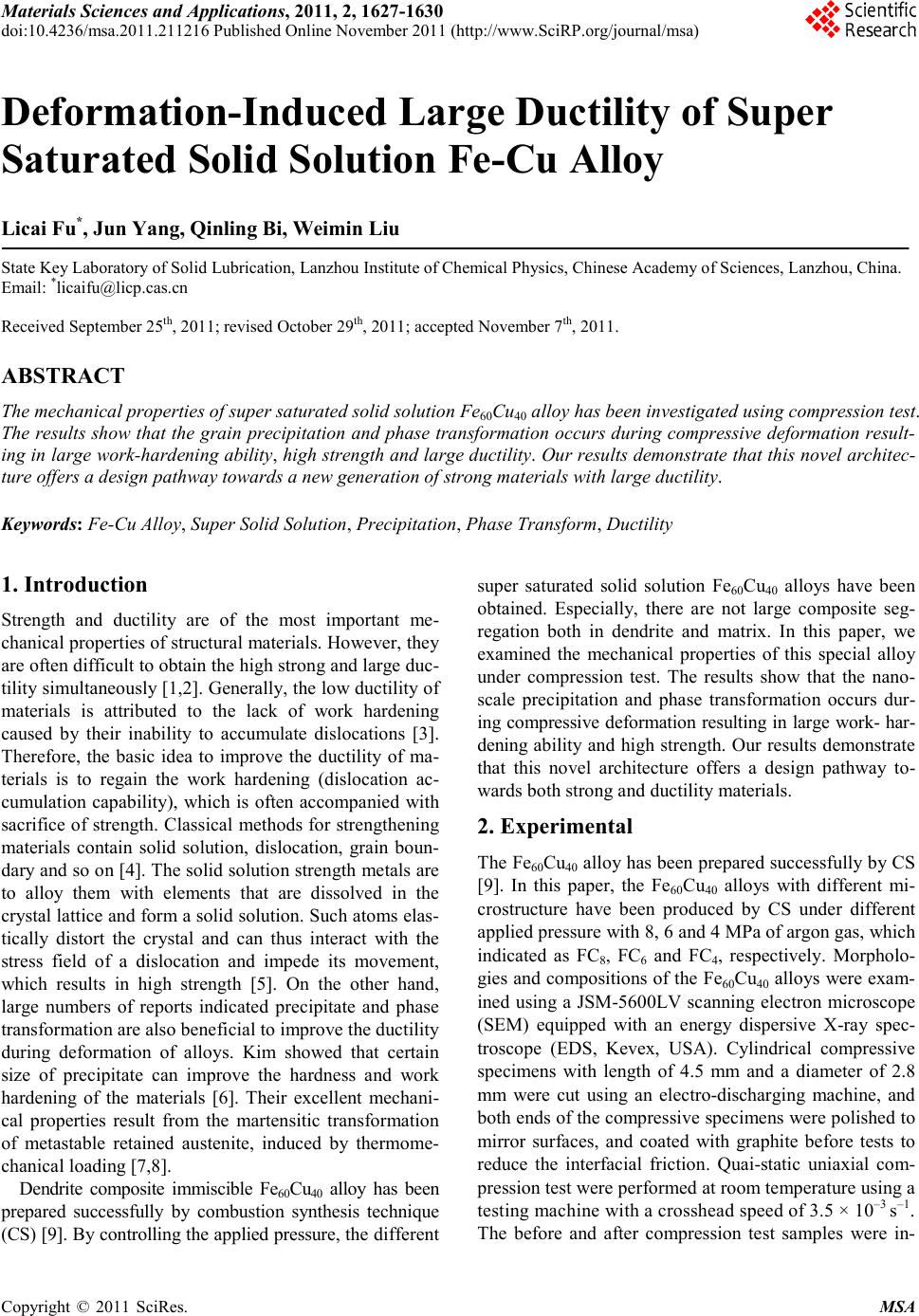
Materials Sciences and Applications, 2011, 2, 1627-1630
doi:10.4236/msa.2011.211216 Published Online November 2011 (http://www.SciRP.org/journal/msa)
Copyright © 2011 SciRes. MSA
1627
Deformation-Induced Large Ductility of Super
Saturated Solid Solution Fe-Cu Alloy
Licai Fu*, Jun Yang, Q i nling Bi, Weim in Liu
State Key Laboratory of Solid Lubrication, Lanzhou Institute of Chemical Physics, Chinese Academy of Sciences, Lanzhou, China.
Email: *licaifu@licp.cas.cn
Received September 25th, 2011; revised October 29th, 2011; accepted November 7th, 2011.
ABSTRACT
The mechanical properties of super saturated solid solution Fe60Cu40 alloy has been investigated using compression test.
The results show that the grain precipitation and phase transformation occurs during compressive deformation result-
ing in large work-hardening ability, high strength and large ductility. Our results demonstrate that this novel architec-
ture offers a design pathway towards a new generation of strong materials with large ductility.
Keywords: Fe-Cu Alloy, Super Solid Solution, Precipitation, Phase Transform, Ductility
1. Introduction
Strength and ductility are of the most important me-
chanical properties of structural materials. However, they
are often difficult to obtain the high strong and large duc-
tility simultaneously [1,2]. Generally, the low ductility of
materials is attributed to the lack of work hardening
caused by their inability to accumulate dislocations [3].
Therefore, the basic idea to improve the ductility of ma-
terials is to regain the work hardening (dislocation ac-
cumulation capability), which is often accompanied with
sacrifice of strength. Classical methods for strengthening
materials contain solid solution, dislocation, grain boun-
dary and so on [4]. The solid solution strength metals are
to alloy them with elements that are dissolved in the
crystal lattice and form a solid solution. Such atoms elas-
tically distort the crystal and can thus interact with the
stress field of a dislocation and impede its movement,
which results in high strength [5]. On the other hand,
large numbers of reports indicated precipitate and phase
transformation are also beneficial to improve the ductility
during deformation of alloys. Kim showed that certain
size of precipitate can improve the hardness and work
hardening of the materials [6]. Their excellent mechani-
cal properties result from the martensitic transformation
of metastable retained austenite, induced by thermome-
chanical loading [7,8].
Dendrite composite immiscible Fe60Cu40 alloy has been
prepared successfully by combustion synthesis technique
(CS) [9]. By controlling the applied pressure, the different
super saturated solid solution Fe60Cu40 alloys have been
obtained. Especially, there are not large composite seg-
regation both in dendrite and matrix. In this paper, we
examined the mechanical properties of this special alloy
under compression test. The results show that the nano-
scale precipitation and phase transformation occurs dur-
ing compressive deformation resulting in large work- har-
dening ability and high strength. Our results demonstrate
that this novel architecture offers a design pathway to-
wards both strong and ductility materials.
2. Experimental
The Fe60Cu40 alloy has been prepared successfully by CS
[9]. In this paper, the Fe60Cu40 alloys with different mi-
crostructure have been produced by CS under different
applied pressure with 8, 6 and 4 MPa of argon gas, which
indicated as FC8, FC6 and FC4, respectively. Morpholo-
gies and compositions of the Fe60Cu40 alloys were exam-
ined using a JSM-5600LV scanning electron microscope
(SEM) equipped with an energy dispersive X-ray spec-
troscope (EDS, Kevex, USA). Cylindrical compressive
specimens with length of 4.5 mm and a diameter of 2.8
mm were cut using an electro-discharging machine, and
both ends of the compressive specimens were polished to
mirror surfaces, and coated with graphite before tests to
reduce the interfacial friction. Quai-static uniaxial com-
pression test were performed at room temperature using a
testing machine with a crosshead speed of 3.5 × 10–3 s–1.
The before and after compression test samples were in-